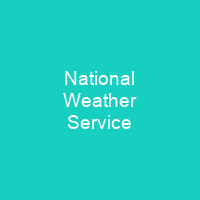The National Weather Service: A Lifeline for Safety and Information
Imagine a world without the National Weather Service (NWS)—a place where severe storms, floods, and other hazardous weather events catch us off guard. The NWS is like a guardian angel, providing critical information that can save lives and protect property. Established in 1870, this agency has evolved significantly over the years to become an indispensable part of our daily lives.
The Genesis of the National Weather Service
Did you know that the idea for a government weather bureau was first proposed way back in 1844? Cleveland Abbe and Increase A. Lapham were among the early pioneers who recognized the need for public weather forecasts and storm warnings. Their efforts laid the groundwork for what would eventually become the National Weather Service.
Evolution Through the Decades
The NWS has undergone numerous changes since its inception, moving from the Department of War to the Department of Agriculture in 1891, and finally settling under the National Oceanic and Atmospheric Administration (NOAA) in 1970. Each transition brought new responsibilities and technologies that have transformed how we receive weather information today.
Technological Advancements
From the first Weather Bureau radiosonde launched in Massachusetts in 1937 to the deployment of NEXRAD (Next Generation Radar) systems between 1988 and 1997, technology has played a crucial role in enhancing weather forecasting. These advancements have significantly improved our ability to predict severe local storms and hydrological events.
Modern Observations and Products
The NWS now operates an extensive network of observation systems, including the ASOS (Automated Surface Observing Systems) network, Cooperative Observer Program (COOP), and various marine observing programs. These systems provide hourly observations that are vital for weather forecasting, research, and alerting the public to hazardous events.
Issuing Warnings and Advisories
The NWS issues a wide range of products designed to keep us informed about potential hazards. From Hazardous Weather Outlooks and Advisories to Watches and Warnings, these tools help people prepare for severe weather conditions. A watch means hazardous weather is possible but not imminent; a warning indicates that dangerous weather or hydrologic events are occurring, imminent, or highly likely.
Advanced Technologies
The NEXRAD Doppler weather radar system, fully deployed by 1997, has been instrumental in improving the detection and warning time of severe local storms. This technology uses advanced information processing, display, and telecommunications systems to provide real-time data that can save lives.
Supporting Communities
The NWS goes beyond just issuing warnings; it also provides on-site support through Incident Meteorologists (IMETs) during large wildfires or disasters. These meteorologists travel quickly to incident sites, assemble mobile weather centers, and provide continuous meteorological support for incidents.
Aviation Support
In addition to its terrestrial services, the NWS supports aviation by producing Terminal Aerodrome Forecasts (TAFs) and River Forecast Centers. These centers issue daily river forecasts using hydrologic models based on rainfall, soil characteristics, and other variables, ensuring that pilots and travelers have accurate information.
Conclusion
The National Weather Service is a vital institution that has evolved to meet the needs of an increasingly complex world. From its humble beginnings in 1870 to today’s advanced technologies, the NWS continues to be a beacon of safety and information for millions of people across the United States.

You want to know more about National Weather Service?
This page is based on the article National Weather Service published in Wikipedia (retrieved on March 1, 2025) and was automatically summarized using artificial intelligence.




